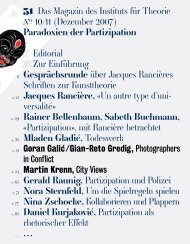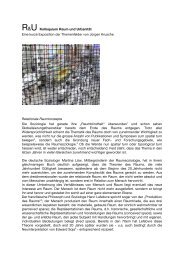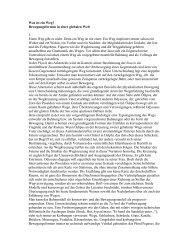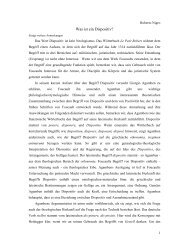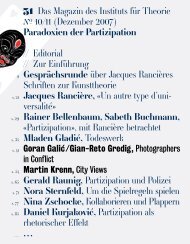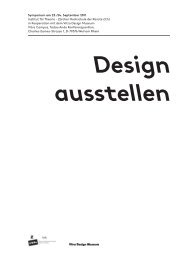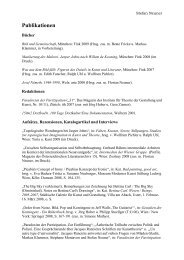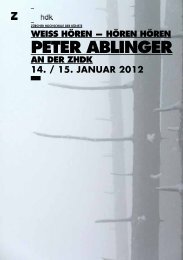PDF des gesamten Heftes (5MB) - Institut für Theorie ith
PDF des gesamten Heftes (5MB) - Institut für Theorie ith
PDF des gesamten Heftes (5MB) - Institut für Theorie ith
Sie wollen auch ein ePaper? Erhöhen Sie die Reichweite Ihrer Titel.
YUMPU macht aus Druck-PDFs automatisch weboptimierte ePaper, die Google liebt.
81<br />
31 — # 08/09 (Dezember 2006)<br />
Das Magazin <strong>des</strong> <strong>Institut</strong>s <strong>für</strong> <strong>Theorie</strong><br />
der Gestaltung und Kunst Zürich (<strong>ith</strong>)<br />
_–<br />
_–<br />
_–<br />
different kind of sense. The films are a<br />
different way to ask different questions,<br />
and the multi-media answers are more<br />
complex than simple writing can ever<br />
be.<br />
SL The way the art lovers speak about<br />
art in those ArtClips — one could think<br />
of that as a performative perception of<br />
art: a flow of analytical, yet very subjective<br />
thoughts.<br />
What was your original interest in producing<br />
these ArtClips as audience interaction?<br />
Were the art lovers involved in<br />
the research project and thus coached<br />
(i.e. introduced to or familiar w<strong>ith</strong> the<br />
interdisciplinary methods of art theory)<br />
before giving their ‹monologues› in<br />
front of the artworks? Do you understand<br />
their speech as «doing theory»?<br />
How does the «Werkanalyse» in front of<br />
the camera differ to the one on paper?<br />
Does the actual presence of the artwork<br />
influence the interpretation? Do these<br />
Clips exemplify your theory of the role<br />
of the art work as an active producer of<br />
the viewer’s subjectivity, the notion of<br />
knowledge as active production? Could<br />
you elaborate on the interrelation between<br />
the subject (the viewer) and the<br />
object (the art work) as well as the role<br />
of the camera in it?<br />
MB The speakers in the clips were not<br />
coached, and they were not involved in<br />
the project. I just asked them to show<br />
up at the location at a certain point in<br />
time. For me, their lack of involvement<br />
in my project was crucial: only then<br />
would I be able to learn something new.<br />
For example, the ArtClips, which I<br />
made when in the middle of writing<br />
academic pieces on art, have shown me<br />
beyond the shadow of a doubt that people<br />
looking at artworks can be provoked<br />
to put their responses into words<br />
and thereby come up w<strong>ith</strong> astonishingly<br />
profound ideas. The ability of viewers<br />
to both bypass and benefit from<br />
insights that circulate in criticism and<br />
in academic art history, to connect what<br />
they see w<strong>ith</strong> real-life issues w<strong>ith</strong>out<br />
reducing the art work to a document,<br />
and to say what moves them is important.<br />
No library book will teach me this.<br />
I don’t think the earliest clips are that<br />
good, but the later ones do convey this<br />
convincingly.<br />
The series was meant to offer an<br />
alternative to the expert explaining art<br />
on television. I wanted to stage the<br />
empowered viewer. To legitimate the<br />
personal and the subjective as more<br />
rather than less directly connected w<strong>ith</strong><br />
the art work seemed a valid project.<br />
This was the original motivation. The<br />
characters in the films were not coached<br />
or in any way involved in my<br />
research. On the contrary, I tried to find<br />
people who had no stake in art history.<br />
While this was often difficult for practical<br />
reasons, I never coached them to<br />
say certain things. Hence, yes, this is a<br />
form of performative perception, a performance<br />
of art viewing recorded while<br />
it was happening. This aspect has had<br />
a great impact on my later film work,<br />
especially in the installation work<br />
Nothing is Missing.<br />
SL The ArtClips were screened in prominent<br />
art institutions such as the Centre<br />
Pompidou and the Whitechapel.<br />
Were they considered as an instrument<br />
of reflection/perception/contextualisation<br />
or as an art project? How did the<br />
media/audience react? Artists like<br />
Andrea Frazer, for example, w<strong>ith</strong> her<br />
talks on art works have used similar<br />
approaches that are perceived as artistic<br />
concepts and ‹institutional critique›.<br />
What is the difference between your<br />
approach and that of an artist? Artists<br />
work w<strong>ith</strong> the theories and methods of<br />
scholars, and scholars w<strong>ith</strong> the methods<br />
and concepts of artists — where do you<br />
see synergies, differences, dangers? Is<br />
this the extension of academic interdisciplinarity<br />
into cultural analysis: the<br />
interdisciplinarity of cultural production<br />
and cultural analysis?<br />
)




